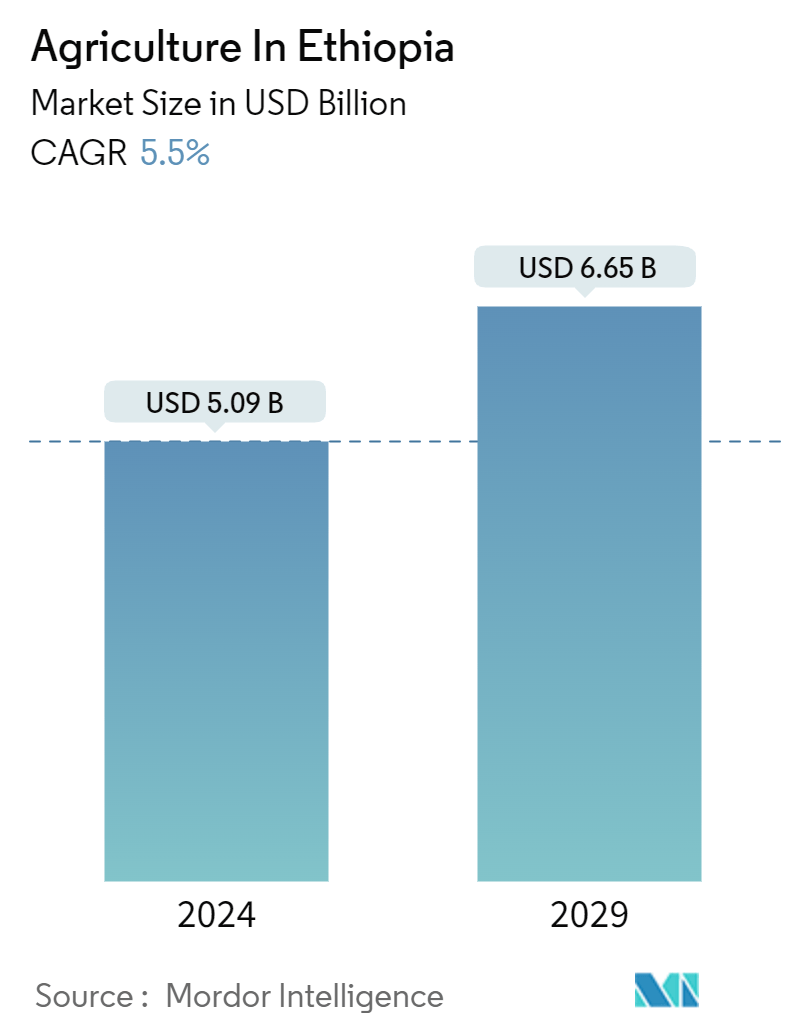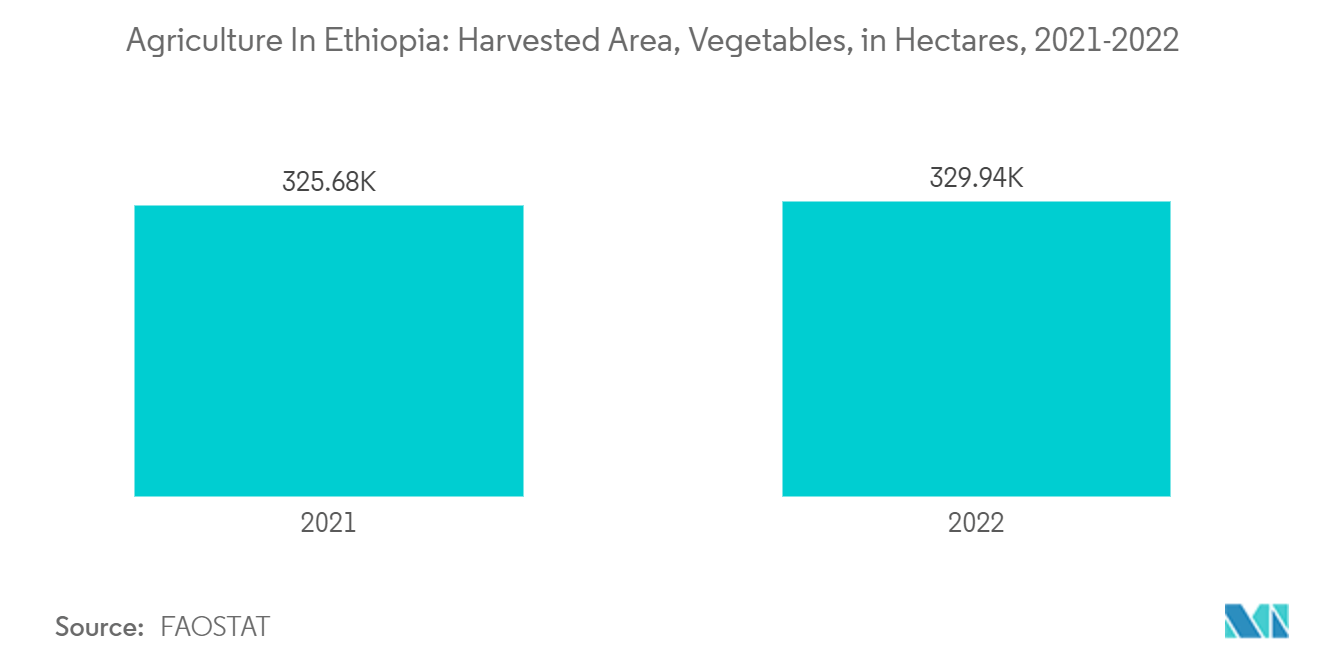Ethiopia Agriculture Market Size

| Study Period | 2019 - 2029 |
| Base Year For Estimation | 2023 |
| Forecast Data Period | 2024 - 2029 |
| Market Size (2024) | USD 5.09 Billion |
| Market Size (2029) | USD 6.65 Billion |
| CAGR (2024 - 2029) | 5.50 % |
Major Players*Disclaimer: Major Players sorted in no particular order |
Ethiopia Agriculture Market Analysis
The Agriculture In Ethiopia Market size is estimated at USD 5.09 billion in 2024, and is expected to reach USD 6.65 billion by 2029, growing at a CAGR of 5.5% during the forecast period (2024-2029).
- Agriculture is one of the largest components of the Ethiopian economy, accounting for 40% of GDP, 80% of exports, and employs about 75% of the country's workforce. The country's agriculture sector is affected by factors such as weak market linkages and limited use of inputs such as improved seeds, fertilizers, and pesticides.
- Despite numerous challenges, the country has ample opportunities to commercialize fruits, vegetables, and ornamental plants, owing to its proximity to Middle Eastern nations. The favorable government policies encouraging the private sector and the advantageous agro-climatic conditions are the two major drivers of the market's growth.
- Smallholder farmers having less than one hectare of land constitute the major farming section of the country as they are responsible for over 95% of the agriculture production. The majority of these farmers are engaged in cereal production, which is the major staple food for people in Ethiopia. Along with cereal production, the livestock feed industry is also growing as the country hosts one of the largest livestock populations in Africa, with 50 million cattle, 50 million goats and sheep, camels, chickens, etc.
- Furthermore, the government's efforts to support the agriculture sector in the country are anticipated to support the growth of the market studied. For instance, in November 2022, the Ministry of Irrigation and Lowlands launched the Powering Agriculture in Ethiopia project in partnership with Power for All. The project aims to sustainably energize Ethiopia's agricultural system by utilizing decentralized renewable energy solutions (DREs) to improve productivity and income.
- Therefore, agriculture being one of the key sectors in the country, favorable agro-climatic conditions along with initiatives taken by the government are anticipated to drive the growth of the market in the coming years.
Ethiopia Agriculture Market Trends
Increasing Focus on Agriculture Development
- The key component of Ethiopia's agriculture policy is expanding the primary and processed agricultural products. As a result, the Government of Ethiopia has identified two of its crucial areas, which are increasing the productivity of smallholder farms and expanding the large-scale commercial farms. To spur the economic growth of Ethiopia in the future, the government has initiated the Second Growth and Transformation Plan (GTP II) to make the agro-processing industry a single entity by encouraging private sector investments within the country through commercial and contract farming. The GTP II is also aimed at developing agro-processing and value addition of agricultural products in the country.
- The Ethiopian government has established the Agricultural Transformation Agency (ATA) to address the problems of the agricultural sector in Ethiopia. It aims to transform smallholder farmers into commercialized players with high incomes. In 2021, the Government of Ethiopia (GOE) embarked on a 10-year economic development plan (2021-2030) where agriculture is the top priority sector and enhancing agricultural production and productivity is one of the major strategic pillars. The 10-year development plan also aims at boosting agricultural export revenues and substituting imports by reducing production costs by using unutilized arable land, modernizing production systems, and improving technology uptake.
- Due to the increasing agriculture business in the country, the area of various crops grown in the country has gradually increased over the years. For instance, according to Food and Agricultural Organization Statistics (FAOSTAT), the harvested area of vegetables increased from 325,677 hectares in 2021 to 329,940 hectares in 2022. Therefore, the government's favorable policies to increase private partnerships in the agricultural sector are anticipated to drive the country's agricultural sector.

The Food Crops Segment Holds Significant Share by Type
- Production of food crops such as cereals accounts for one of Ethiopia's significant shares of the economy from the agricultural sector. Over 80.0% of agricultural land is used to produce cereals, using 60.0% of the rural workforce. According to FAOSTAT, the area under cereals cultivation increased from 10,582,984 hectares in 2021 to 11,236,673 hectares in 2022. Cereals are an essential part of the Ethiopian diet. As per the International Trade Administration report, over 50% of the daily caloric intake of an average household in Ethiopia is from wheat, sorghum, and corn.
- Despite the high domestic grain production, the country is still dependent on wheat imports, which are managed entirely by the state-trading arm of Ethiopian Trading Business Corporation. Despite the country's reliance on wheat imports, the Government of Ethiopia vowed to begin exporting wheat to neighboring countries by tapping into its huge production potential and expanding the wheat production area. Furthermore, despite the huge availability of fertile land for agriculture, the country fails to produce high yields of cereals due to low infrastructure, backward technology implementations, limited input availability, and lack of machinery and irrigation facilities.
- The government has also established agricultural machinery rental service centers in grain-producing regions to capacitate and increase the efficiency of farmers. The country's efforts to increase the production areas aimed at attaining self-sufficiency and export of grains in the international market are anticipated to be the major factors driving the growth of agriculture in Ethiopia.

Ethiopia Agriculture Market News
- October 2022: Ethiopia launched the Distributed Renewable Energy-Agriculture Modalities (DREAM) project with USD 20.5 million. The project was expected to be implemented in regions of Oromia, Amhara, Sidama, and South Nations, Nationalities, and Peoples' Region. It aims to increase agricultural productivity by providing solar mini-grids for improved irrigation services.
- May 2022: The GFA Consulting Group started two new projects as part of Strengthening Rural Value Chains (SRVC), which comes under the Promoting Agricultural Productivity in Ethiopia project of the German Development Corporation. The project aims to strengthen business associations in the agricultural sector by increasing access to inputs, services, and markets in agriculture value chains in Sidama, Oromia, and Amhara regions.
Ethiopian Agriculture Market Report - Table of Contents
1. INTRODUCTION
- 1.1 Study Assumptions and Market Definition
- 1.2 Scope of the Study
2. RESEARCH METHODOLOGY
3. EXECUTIVE SUMMARY
4. MARKET DYNAMICS
- 4.1 Market Overview
-
4.2 Market Drivers
- 4.2.1 Increasing Focus on Agriculture Development
- 4.2.2 Adoption of Advanced Technologies in Agriculture
- 4.2.3 Increasing Government Initiatives
-
4.3 Market Restraints
- 4.3.1 Low Productivity of Agricultural Lands
- 4.3.2 Inadequate Financing in the Agriculture Sector
5. MARKET SEGMENTATION
-
5.1 Type
- 5.1.1 Food Crops
- 5.1.2 Fruits
- 5.1.3 Vegetables
6. REGIONAL ANALYSIS
- 6.1 PESTLE Analysis
- 6.2 Value Chain Analysis
- 6.3 Government Policies
7. COMPETITIVE LANDSCAPE
- 7.1 Distribution Network and Retail Analysis
- 7.2 List of Distributors/Traders
8. MARKET OPPORTUNITIES AND FUTURE TRENDS
** Subject To AvailablityEthiopia Agriculture Industry Segmentation
Agriculture in Ethiopia involves the production of various food crops, such as fruits and vegetable crops.
The market for agriculture in Ethiopia is segmented by type (food crops, fruits, and vegetables). The report includes the production analysis (volume), consumption analysis (value and volume), export analysis (value and volume), import analysis (value and volume), and price trend analysis. The report offers the market size and forecast by volume (metric tons) and value (USD) for the above segments.
| Type | Food Crops |
| Fruits | |
| Vegetables |
Ethiopian Agriculture Market Research FAQs
How big is the Ethiopia Agriculture Market?
The Ethiopia Agriculture Market size is expected to reach USD 5.09 billion in 2024 and grow at a CAGR of 5.5% to reach USD 6.65 billion by 2029.
What is the current Ethiopia Agriculture Market size?
In 2024, the Ethiopia Agriculture Market size is expected to reach USD 5.09 billion.
What years does this Ethiopia Agriculture Market cover, and what was the market size in 2023?
In 2023, the Ethiopia Agriculture Market size was estimated at USD 4.81 billion. The report covers the Ethiopia Agriculture Market historical market size for years: 2019, 2020, 2021, 2022 and 2023. The report also forecasts the Ethiopia Agriculture Market size for years: 2024, 2025, 2026, 2027, 2028 and 2029.
What government policies and initiatives are supporting agricultural development in Ethiopia?
The government policies and initiatives that are supporting agricultural development in Ethiopia are a) Land tenure reforms b) Access to credit programs c) Infrastructure projects
What government policies and initiatives are supporting agricultural development in Ethiopia?
The government policies and initiatives that are supporting agricultural development in Ethiopia are a) Land tenure reforms b) Access to credit programs c) Infrastructure projects
Agriculture in Ethiopia Industry Report
The Agriculture Sector in Ethiopia Report is segmented by type, including food crops, fruits, and vegetables. The report provides an in-depth analysis of production, consumption, exports, imports, and price trends. This comprehensive industry analysis highlights Ethiopia's agriculture sector, which is predominantly driven by smallholder farmers. These farmers are crucial for the production of cereals and livestock feed, making significant contributions to the market size.
Despite facing infrastructural and technological challenges, the agriculture industry in Ethiopia shows promising growth prospects. Governmental strategies aimed at modernizing the sector are pivotal for enhancing productivity and attracting private sector investments. These strategies focus on agro-processing capabilities and expanding export revenues, which align with the market growth objectives.
Ethiopia's efforts to expand crop cultivation areas and adopt advanced technology are essential for improving efficiency. This positions the country as a potential net exporter, especially in the cereals segment. The government, through various agencies, supports transitioning smallholder agriculture towards more commercial and profitable models, which is expected to significantly boost market growth.
The market overview includes detailed insights into market data, market forecast, and market segmentation. Additionally, the industry's outlook and market predictions are crucial for understanding future trends. The report also covers industry statistics, industry information, and industry trends to provide a comprehensive view of the sector.
Industry research and industry reports are essential for stakeholders to make informed decisions. The market review and market value analysis offer a detailed perspective on the sector's performance. Research companies play a vital role in compiling this valuable industry information, which is available in report pdf format for ease of access.
The report example provided by industry leaders showcases the importance of market analysis and market growth strategies. This industry profile emphasizes the significance of understanding the market structure and industry forecast to stay ahead in the competitive landscape.
In conclusion, the Agriculture Sector in Ethiopia Report is a vital resource for anyone interested in the industry. It covers all aspects of the market, including industry sales, industry size, and industry outlook. The detailed analysis ensures that stakeholders have access to the necessary information to navigate the market effectively.



